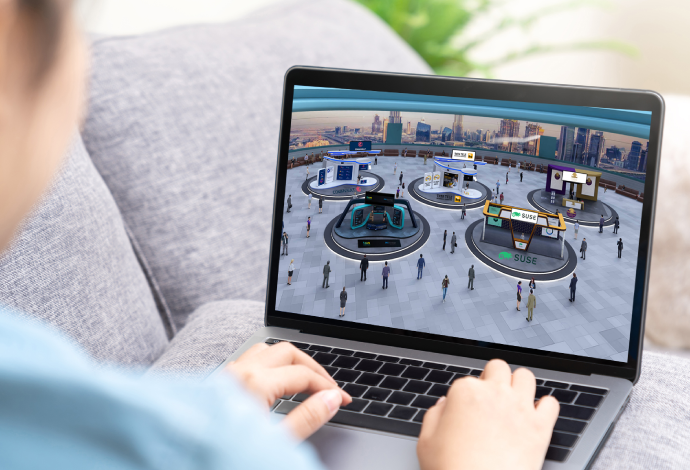While there is a disruption in the physical event venue, virtual event venues are expanding. With an uptick in virtual events and virtual event platforms, there has been a rising demand for the virtual expo, meetings, conferences, trade shows, and many more.
Regarding virtual exhibitions and expos, they are very important for several organizations, businesses, and industries. It helps them expand their business community and showcase their products and offering to a large spectrum of people.
To elevate the level of online expos, let us walk you through some best practices and ideas;
Table of Contents
Step 1: Identify Your Event and Business Objectives

Many people prefer to host virtual events or expos just because they are flexible and cost-effective. Do not be under this impression. Before you plan out the agendas and aspects of the expos, it is important to be clear with your business and event goals. Ask a few questions to yourself like “Whether you are proposing to conduct an online expo to drive more sales? Or to obtain more business leads? Do you wish to display the latest product offerings to a wide reach of people? Whatever is the objective of planning an online expo, the organizer should be well aware of it. It helps in devising realistic and productive event planning and approach to deliver a successful virtual exhibition and expo.
Step 2: Begin With an Effective Plan
Once the objectives of conducting a virtual expo are transparent, move forward with virtual expo planning and strategy. Create an efficient game plan to make your virtual expo successful and unique. Answer the subsequent questions to yourself:
- Will your expo be live, on-demand, or both?
- Will it be chargeable or free?
- What will be the registration process?
- How will the audience interact at your virtual exhibition?
- What will be the engaging features of your event?
- How would your participants access the online expo?
- How many exhibitor booths would be there?
- What networking options do you want at the virtual booths?
- Will you provide product brochures at the virtual booths?
- How will you track the attendee footprint?
After examining all the vital questions, follow effective and strategic planning to host a successful virtual expo.
Step 3: Understand Your Target Audience

It is vital to understand the aspirations, expectations, and needs of your target audience. A deep understanding of the audience and their expectations will help you conduct a more value-yielding expo. Your content, virtual booths, stand designs, and the entire virtual stage should be designed based on the preferences and yearnings of the attendees.
Step 4: Schedule the Date and Time Carefully

After identifying the goals and target audience, it is vital to schedule the event timings in the next step. Look for an ideal date that does not collide with any other industry event. A significant portion of the count of attendees depends on your event timings. Avoid conducting your event on national holidays, weekends, around Christmas or New Year time, or Election Day. While targeting a global audience, ensure to avoid the issue of different timezones. Therefore, take your time, do thorough research, and make a wise decision for the same.
Step 5: Be Wise in Choosing Your Virtual Expo Platform
Leveraging the best event technology and the appropriate virtual expo platform plays a key role in hosting a successful online expo and exhibition. There’s enormous competition between different virtual event providers. Therefore, choose a customizable and all-in-one virtual event technology to stand out in your event.
It is advisable to look for virtual expo software that can seamlessly facilitate your event and business goals. Hunt for an online expo platform that allows you to create customizable 3D virtual exhibitor booths, provide live chat functionality and other engaging features. The live chat feature allows participants to have 1:1 or group chats through live audio, video, and text chats. And other engaging features include live polls, surveys, Q&A sessions, gamification, photo booths, social walls, etc to keep the attendees involved in the event.
The virtual event venue you employ should also have strong data tracking feature. It should be able to keep the count of registrations, track attendee navigation, the details of the most visited exhibitor booth, number of downloads, data shared at the exhibitor booth between the exhibitor and attendee.
This valuable data helps in providing detailed analytics reports and evaluate performance metrics. Furthermore, ask your virtual expo service provider to present a demo to have a profound understanding of the platform and its features. It will help you with a rough concept about how it will profit your virtual exhibitions and shows.
Step 6: Design an Impressive 3D Virtual Stage
The remarkable 3D design of your virtual stage plays a vital role in delivering impactful experiences. The 3D virtual environment brings your speaker from any location and allows them to interact with the audience through visuals, animations, lively imagery, eye-catching graphics, videos, and more. If you are attempting to replicate the privileges of in-person networking and make a 1:1 connection during your online expo, then the 3D stage is an excellent option. The 3D virtual expo platforms offer an opportunity to improve user experience using a virtual 3D world.
Step 7: Make Your Expo Super Engaging
Think of adding more interactive features to your online exhibition to make it even more likable. Create exciting content and appoint incredible speakers who hold the expertise of keeping the attendees engaged throughout the event. Also, make sure that the content is easily accessible by the attendees during the online event. Allow the attendees to download and share files, audio, PDFs, documents, videos, content at online expos. To make your sessions more engaging, include live polls, surveys, and Q&A sessions to promote real-time interactions.
Make the most of virtual networking tables like live chat, audio, and video features to encourage 1:1 and group discussions between the exhibitors and attendees. Consider using pop-up features or push-up notifications to keep the attendees notified about the ongoing and upcoming sessions.
Such on-event announcements are an effective strategy to keep the attendees involved and hooked throughout the event.
Step 8: Include Distinguished Stand Designs
Create stunning stand designs to draw and overwhelm virtual attendees. Determine in the beginning while doing the virtual expo planning whether your booth stand design will be in 2D or 3D. Select it based on your budget, attendee segment, and timeframe to deliver immersive online expo experiences.
Step 9: Keep Customizable Virtual Booths

Create visually rich, interactive, and customizable floor designs to lure more attendees and keep platform navigation simple and convenient. The interactive floor design should allow the audience to just click at the branded logo stands to enter an exhibitor’s booth. It also empowers attendees to decide on the virtual booth where they would like to spend much of their time. Customizable booths allow the exhibitors to decide how they want to display their brand logo, products, content, or services to draw more attendees and prospect leads.
Step 10: Add More Exciting Features
Consider including fun and enjoyable elements in your exhibition to make it more interesting. Features like a social wall, photo booths, a signature wall, games (spin the wheel, trivia, tic-tac-toe, crosswords, etc) help recreate on-site event experiences. Attendees would love to take back memorable experiences by capturing photos in branded booths or writing down their fond memory on the social wall.
People love to play games – be it a physical, virtual, or hybrid event. Games like spin the wheel, trivia, tic-tac-toe, crosswords are excellent ways to promote engagement and keep your attendees involved. You can also incorporate a leaderboard challenge to promote the active participation of the attendees. A leaderboard challenge awards points for each activity or for winning a game. It is an effective strategy to make way for healthy competition.
Step 11: Make Way for New Connections
Networking is one of the major criteria why vendors, exhibitors, speakers, and attendees participate in expos. Therefore, it is vital to prioritize networking at these expos and exhibitions. You can include AI matchmaking, virtual networking tables, a business card exchange feature, a B2B meetings scheduler, live chat functionality to let attendees and exhibitors interact, connect, and make new relationships.

Using a B2B meetings scheduler, any attendee and exhibitor can decide a mutual time to meet and discuss even after the expo is over. And, AI matchmaking makes it easier to connect with like-minded people at the event. These features avoid the need of waiting in long queues to meet the exhibitor. Besides, exhibitors also find it easy to obtain more leads and sales opportunities.
Step 12: Promote Your Virtual Expo
Now that your timings and goals are decided, and your exhibitors are onboard, you have to think about luring more participants to sign up. Make the most of different marketing channels like social media platforms, email marketing, SEO-optimized blogs.

Create compelling landing pages that consist of the date and time of your virtual expo, engaging clips of the speaker, names of some renowned speakers, and exhibitors to draw more participation. Look for an impressive headline, event-specific hashtags, use eye-catching visuals, and most importantly, make your efforts on how to spread the word regarding your virtual event.
Besides this, you can also ask your exhibitors and speakers to post expo-specific updates on their social media handles to let their followers and fan base know about your expo.
Step 13: Track Attendee Footprint and Get Detailed Analytics
Digital footprinting allows you to maintain a record of each attendee move. From how many people registered, the count of attendees, Was the platform navigation simple?, Whom did they interact with?, Which virtual booths were the engagement hotspots?, What was the count of downloaded content? What information did the attendees share? An ideal virtual expo platform keeps a record of each minute detail. It helps in generating an analytics report that helps in gauging the success of the virtual expo. This advantage of virtual expos outrun their physical counterparts.

Step 14: Take a Follow-up
Taking the valuable feedback of the attendees is very crucial to understand the opportunity area of your event. It helps you make significant improvements to plan even better online exhibitions and expos. Therefore, you can send a simple feedback survey on the emails of the attendees to collect the relevant feedback of the attendees.
Wrapping Up
These are some of the best practices you can inculcate for hosting memorable virtual exhibitions and expos. Bizarre online expos call for the right event technology, digitalization, strategic approach, and event experience. If you are new to this virtual sphere, make sure to employ an all-in-one virtual expo platform to deliver impactful and unique experiences.




















